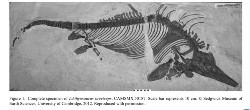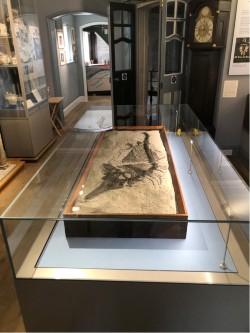Lyme Regis Museum on the Dorset coast is celebrating the life and work of one the town’s most famous daughters, Mary Anning, with a rarely seen portrait of the renowned paleontologist, an exhibition featuring one of her rare ichthyosaurs and a stunning newly discovered genus and species of extinct marine ‘crocodile’ found by two local fossil hunters. The museum stands on Mary’s former home on the sea front in Lyme, where a statue by Denise Dutton was unveiled at the weekend after a campaign by a local fundraising group, Mary Anning Rocks, to mark her 222nd birthday. Mary’s portrait is on loan from the Geological Society and is on public display in Lyme Regis for the first time. Painted in pastels, it is the work of local artist, Benjamin Donne, who would have known Mary and depicts her with her faithful dog, Tray, on the beach at Lyme.
Displayed alongside the picture is a very rare Ichthyosaurus breviceps discovered by Mary in 1832, which is on loan from the Sedgwick Museum of Earth Sciences in Cambridge. No complete Mary Anning ichthyosaurus has ever been on show in Lyme until now. Also on show for the first time is an exciting new acquisition, a recently discovered genus and species of extinct marine thalattosuchian crocodylomorph discovered by Paul Turner and Lizzie Hingley a short distance from where Mary herself would have gone fossil hunting. Museum Director, Bridget Houseago, says: “We are delighted to bring Mary’s portrait and one of her famous ichthyosaurs back to Lyme Regis. It is a wonderful way to mark Mary’s birthday, the end of our centenary year, and to celebrate Lyme’s pioneering fossil hunter. We are delighted to have these precious objects on loan, and we hope our visitors will enjoy seeing them. “It is thought the portrait was a commission, which was then bought by a collector and donated to the Geological Society in Piccadilly, London, in 1875, where it has hung ever since. The irony was that Mary was not allowed to be a member of the society, because she was a woman, but they obviously valued her work and expertise, because her portrait has hung there for all this time – the only female in a pantheon of famous fathers of science.” Richard Hughes, Executive Secretary of the Geological Society, says: “The Geological Society is proud to be associated with the museum’s new exhibition on the life of Mary Anning and we are happy that we could assist with the loan of this now iconic portrait. Although many people have seen it hanging in the society’s premises at Burlington House, we hope many more will be able to see it on display in the town that was her home.” Ms. Houseago adds: “The ichthyosaur is exceedingly rare; it is incredibly significant for us to have it on show here in Lyme. We have several smaller pieces found by Mary, but this almost complete ichthyosaur was unearthed by her 200 years ago and then sold to Adam Sedgwick of the museum which bears his name.

|
|

|
The director of the Sedgwick Museum Dr Liz Hide, says: “In 1832, Mary Anning wrote to Professor Adam Sedgwick, describing this ichthyosaur as 'the best yet discovered’. He paid her £35 for it, and it was shipped to Cambridge where it went on display. 190 years later, we in the Sedgwick Museum are delighted see it back in Lyme as part of the celebration of this remarkable and inspiring woman.” The' Charmouth Crocodile’ was found by Paul Turner and Lizzie Hingley on the beach below Stonebarrow cliff in 2017 where it had been washed out of a landslip by stormy weather. Dr Paul Davis, Geology Curator at Lyme Regis Museum, says: ‘We are incredibly lucky to work with the excellent local collectors Paul and Lizzie and to benefit from their generous donation of this incredibly important specimen, which is so unique nobody, not even Mary Anning, has found one of these crocodylomorphs at Lyme Regis in the last 200 years.” The exhibition runs until the end of September.
ADDITIONAL INFORMATION Paul Turner found the first and most of the blocks containing the bones of the crocodile. The specimen was recorded under the West Dorset Fossil Collecting Code due to its rarity. Paul and Lizzie (aided by Phil Davidson from the Charmouth Heritage Coast Centre), then revisited the site every day for several weeks to make sure that they recovered every piece as it was washed out of the landslip and to prevent it being destroyed by the sea. Even so, some bones were found by other fossil hunters, and they have also kindly donated their finds to keep the specimen complete.
The specimen is currently being studied by an international team of scientists who will name and describe the specimen and use it to explain the evolution of the thalattosuchians from their ancestors. As the specimen is a completely new animal, it will get a new scientific name. It is going to be named after Paul and Lizzie and likely to be called Turnerosuchus hingleyi (which means Turner and Hingley’s Crocodile).
To find out more please visit the Lyme Regis Museum website.